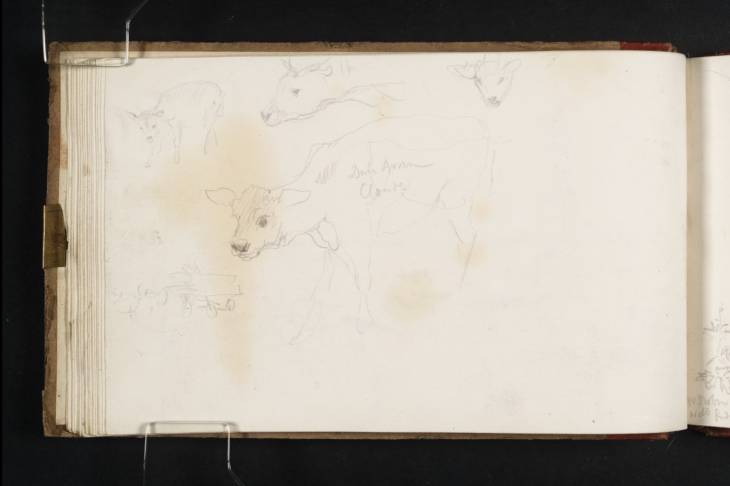Joseph Mallord William Turner Studies of Calves and a Cow; a Wagon 1819
Image 1 of 2
Joseph Mallord William Turner,
Studies of Calves and a Cow; a Wagon
1819
Joseph Mallord William Turner 1775–1851
Folio 22 Verso:
Studies of Calves and a Cow; a Wagon 1819
D14530
Turner Bequest CLXXVI 22a
Turner Bequest CLXXVI 22a
Pencil on white wove paper, 111 x 184 mm
Inscribed by Turner in pencil ‘Dun Brown | Claude’ above centre, on calf
Inscribed by Turner in pencil ‘Dun Brown | Claude’ above centre, on calf
Accepted by the nation as part of the Turner Bequest 1856
References
1909
A.J. Finberg, A Complete Inventory of the Drawings of the Turner Bequest, London 1909, vol.I, p.517, CLXXVI 22a, as ‘Sketches of calves and a wagon. On one of the calves, “Dun Brown, Claude”.’.
1984
Cecilia Powell, ‘Turner on Classic Ground: His Visits to Central and Southern Italy and Related Paintings and Drawings’, unpublished Ph.D thesis, Courtauld Institute of Art, University of London 1984, pp.82, 462 notes 62 and 63.
1985
Jack Lindsay, Turner: The Man and His Art, London 1985, p.96.
1987
Cecilia Powell, Turner in the South: Rome, Naples, Florence, New Haven and London 1987, pp.24, 202 note 39.
1990
Kathleen Nicholson, Turner’s Classical Landscapes: Myth and Meaning, Princeton 1990, p.261 note 50.
2008
James Hamilton, ‘Turner e l’Italia’ in Hamilton, Nicola Moorby, Christopher Baker and others, Turner e l’Italia, exhibition catalogue, Palazzo dei Diamanti, Ferrara 2008, p.43.
2009
James Hamilton, ‘Turner’s Route to Rome’ in Hamilton, Nicola Moorby, Christopher Baker and others, Turner & Italy, exhibition catalogue, National Galleries of Scotland, Edinburgh 2009, p.42.
These studies of what may be aspects of a single calf, together with a cow’s head in profile, fall among the very few sketches after Turner’s leaving Venice until his arrival at Bologna; for Cecilia Powell’s comments, see under folio 21 verso (D14528).1 As James Hamilton has put it, ‘Turner refers to little except a charming drawing of a calf’,2 which may have been observed at the villa or farm shown on folio 23 recto opposite (D14531). This is the only page of animal drawings in this sketchbook; for a few figure studies, see under folio 1 recto (D14489). Studies of cattle feature here and there in Turner’s sketchbooks, including the self-explanatory Cows of about 1801 (Tate; Turner Bequest LXII) as potential elements of rural paintings.
Turner’s note on the central animal, ‘Dun Brown | Claude’, refers to the French, Rome-based artist Claude Lorrain (1604/5–1682), whom he greatly admired and often emulated in terms of his idealised, light-filled classical landscapes and harbour scenes;3 Claude was clearly on his mind as he moved south towards Rome, and here it is a rather mundane instance of colour rather than light that has evoked the comparison, presumably with the brown washes of Claude’s drawings and perhaps the ‘sepia’ tones of the engravings after his Liber Veritatis compositions which had been an important influence on Turner’s own printmaking (see the Introduction to the ‘Liber Studiorum c.1806–24’ section of the present catalogue). The artist would have to wait a little longer in his journey to encounter a landscape worthy of comparison with his forerunner’s, making an approving note of the ‘first bit of Claude’ below a hilly scene with distant buildings in his subsequent Ancona to Rome sketchbook (Tate D14663; Turner Bequest CLXXVII 6).
How to cite
Matthew Imms, ‘Studies of Calves and a Cow; a Wagon 1819 by Joseph Mallord William Turner’, catalogue entry, March 2017, in David Blayney Brown (ed.), J.M.W. Turner: Sketchbooks, Drawings and Watercolours, Tate Research Publication, July 2017, https://www


